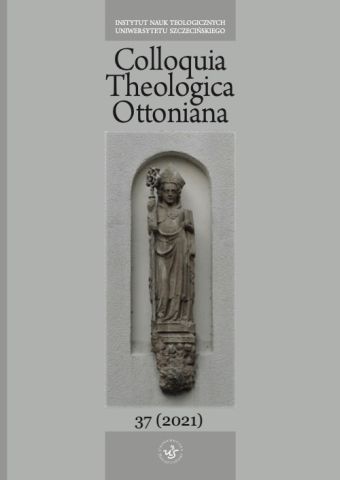
ISSN: 1731-0555
eISSN: 2353-2998
OAI
DOI: 10.18276/cto.2021.37-10




Issue archive /
37/2021
Reakcja na zagrożenie koronawirusem – analiza publikowanych treści w początkowej fazie epidemii na oficjalnej stronie Konferencji Episkopatu Polski
(Reaction to the threat of COVID-19: an analysis of the content published in the initial phase of the epidemic on the official website of the Polish Bishops' Conference)
| Authors: |
Rafał Jakub
Pastwa

Katolicki Uniwersytet Lubelski Jana Pawła II, Polska |
| Keywords: | mediatisation mediatisation of religion religious communication Polish Bishops’ Conference digital media Roman Catholic Church COVID-19 pandemic |
| Data publikacji całości: | 2021-12-15 |
| Page range: | 20 (169-188) |
Abstract
The mediatisation of reality has embraced societies and institutions, including religious institutions and religion. This has increased the importance of religious communication, which is part of a broad and complex process of social communication. Its strong position and importance have grown with the development of communication technologies and the popularity of the mass media, especially during the COVID-19 pandemic. The decrease in the number of believers in churches in Poland in March 2020 made the media the dominant platform for religious communication. The processes of the mediatisation of religion and the mediatisation of the Roman Catholic Church in Poland strengthen the position of the media in the transfer of religious content and in creating the image of a church institution. The emergence of COVID-19 in Poland in 2020 triggered a reaction from numerous institutions, including the media. On the official website of the Polish Bishops’ Conference, numerous administrative and pastoral messages appeared, which constituted a specific instruction for the faithful from both the pastoral and institutional perspectives. They were also of interest to the media and the public. The dominance of administrative and pastoral texts published on the website episkopat.pl in the analysed period is in line with the nature and mission of the Church, which cannot be reduced to either a temporal and institutional perspective or a spiritual and salvific perspective alone. The analysis of the content quality allows us to notice a slight shift of emphasis towards the temporal perspective, while in the analysed messages, institutional language, defined by the author as the “language of distance,” prevails.
Download file
Article file
Bibliography
| 1. | Adamski A., Refleksja teologiczna nad naturą Kościoła rzymskokatolickiego a jego wizerunek medialny, s. 41–60, https://dspace.uni.lodz.pl/xmlui/bitstream/handle/11089/28934/41-60_Adamski.pdf?sequence=1&isAllowed=y (dostęp: 27.03.2021). |
| 2. | CBOS, Wpływ pandemii na religijność Polaków, czerwiec 2020, s. 1–11, https://www.cbos.pl/SPISKOM.POL/2020/K_074_20.PDF (dostęp: 28.03.2021). |
| 3. | Draguła A., Kościół realny, a Kościół medialny, „Więź”, https://wiez.pl/2019/01/15/kosciol-realny-a-kosciol-medialny (dostęp: 20.03.2021). |
| 4. | Edelman R., Declaring Information Bancruptcy, https://www.edelman.com/trust/2021-trust-barometer/insights/declaring-information-bankruptcy (dostęp: 22.03.2021). |
| 5. | Gądecki S., Komunikat Przewodniczącego Konferencji Episkopatu Polski w związku z możliwością pojawienia się koronawirusa na terenie Polski, https://episkopat.pl/przewodniczacy-kep-o-koronawirusie-zachecam-duchowienstwo-i-wiernych-do-zachowania-zwiekszonej-ostroznosci-2 (dostęp: 26.03.2021). |
| 6. | Goban-Klas T., Franciszek w erze komunikacji i mediów naszych czasów, w: Sztuka komunikacji według Franciszka. Bliżej – prościej – głębiej, red. M. Laskowska, K. Marcyński, Warszawa 2016, s. 15–31. |
| 7. | Gorbalenya A.E., Baker S.C., Baric R.S. i in., The species Severe acute respiratory syndrome-related coronavirus: classifying 2019-nCoV and naming it SARS-CoV-2, „Nature Microbiology” 5 (2020), s. 536–544, https://www.nature.com/articles/s41564-020-0695-z (dostęp: 26.03.2021). |
| 8. | Hjarvard S., The Mediatization of Society. A Theory of the Media as Agends of Religious Changes, „Northern Lights” 6 [b.r.], s. 1–21. |
| 9. | Jabłonowski M., Gackowski T., Tożsamość nauk o mediach. Obszary, perspektywy, postulaty, „Studia Medioznawcze” 2 (2012) 49, s. 15–24. |
| 10. | Konstytucja dogmatyczna o Kościele, w: Sobór Watykański II, Konstytucje. Dekrety. Deklaracje, Poznań 2002, s. 104–163. |
| 11. | Kowalczyk K., Kościół rzymskokatolicki w Polsce jako podmiot oddziałujący na system polityczny. Casus ustawy o związkach partnerskich, „Colloquium Wydziału Nauk Humanistycznych i Społecznych” 4 (2015), s. 61–82. |
| 12. | Leśniczak R., Komunikowanie polityczne papieża Franciszka na temat uchodźców w kontekście teorii agenda-setting, w: Pulchrum et Communicatio. Księga jubileuszowa Profesora Karola Klauzy, red. A. Wójciszyn-Wasil, M.J. Gondek, D. Wadowski, Lublin 2018, s. 143–157. |
| 13. | Manet P., Gdy Europa zatrze ostatnie ślady chrześcijaństwa, zatopi się w bezkształtnej ludzkości pozbawionej celu istnienia, „Wszystko Co Najważniejsze”, https://wszystkoconajwazniejsze.pl/prof-pierre-manent-chrzescijanstwo-wobec-religii-ludzkosci/?fbclid=IwAR118gJ5dWEHfUNNGiUkSOquL4T2boYy4KG2IDhU3BUfaOFD8Px3EuuHCmw (dostęp: 28.03.2021). |
| 14. | Marcyński K., Komunikacja religijna i media, Kraków 2016, s. 15–24. |
| 15. | Mariański J., Sekularyzacja a nowe formy religijności, „Roczniki Nauk Społecznych” 1 (2009) 37, s. 33–68. |
| 16. | Medicover, Pandemia koronawirusa na świecie i w Polsce – kalendarium, https://www.medicover.pl/o-zdrowiu/pandemia-koronawirusa-na-swiecie-i-w-polsce-kalendarium,7252,n,192 (dostęp: 26.03.2021). |
| 17. | Molęda-Zdziech M., Czas celebrytów. Mediatyzacja życia publicznego, Warszawa 2013. |
| 18. | Pastwa R., Mediatyzacja instytucji Kościoła i strategia personalizacji w kontekście zjawiska prywatyzacji wizerunku księdza na Facebooku, „Biuletyn Edukacji Medialnej” 2 (2018), s. 82–97, https://www.kul.pl/files/819/2_2018/pastwa_bem_2_2018.pdf (dostęp: 28.03.2021). |
| 19. | Pastwa R.J., Komunikowanie religijne na przykładzie Kościoła katolickiego w Polsce z uwzględnieniem kontekstu pandemii koronawirusa, „Kultura – Media – Teologia” 2 (2020) s. 38–60. |
| 20. | Przybysz M., Kościół w kryzysie? Crisis management w Kościele w Polsce, Tarnów 2008. |
| 21. | Rasińska A., Młodzi w Kościele, w: Kościół w Polsce. Raport, Warszawa 2021, s. 119–129, https://ekai.pl/wp-content/uploads/2021/03/Raport-Kosciol-w-Polsce-2021.pdf (dostęp: 20.03.2021). |
| 22. | Rauch J., Let It Be. The greatest development in modern religion is not a religion at all – it’s an attitude best described as ‘apatheism’, „The Atlantic”, https://www.theatlantic.com/magazine/archive/2003/05/let-it-be/302726 (dostęp: 20.03.2021). |
| 23. | Sadłoń W., Wstęp, w: Katolicka Agencja Informacyjna. Kościół w Polsce. Raport, Warszawa 2021, s. 5–11, https://ekai.pl/wp-content/uploads/2021/03/Raport-Kosciol-w-Polsce-2021.pdf (dostęp: 20.03.2021). |
| 24. | Szulich-Kałuża J., Projekty tożsamościowe rodziny upowszechnianie w polskich tygodnikach opiniotwórczych, Lublin 2013. |